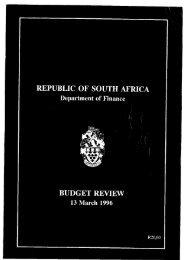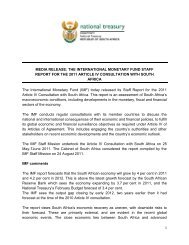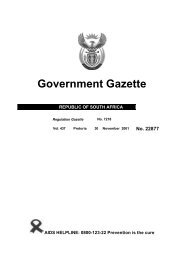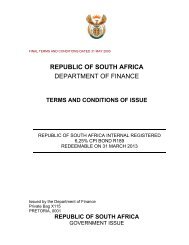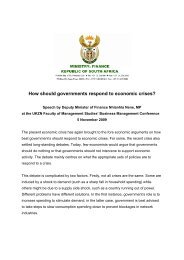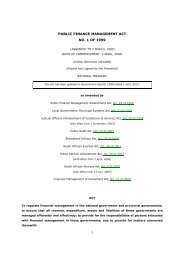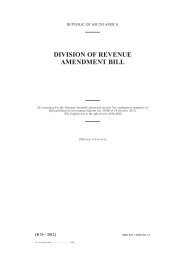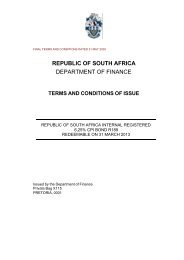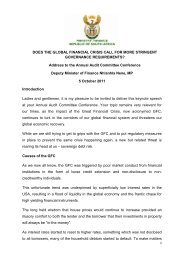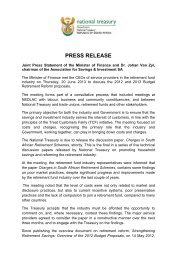1998 SOUTHERN AFRICA ECONOMIC ... - National Treasury
1998 SOUTHERN AFRICA ECONOMIC ... - National Treasury
1998 SOUTHERN AFRICA ECONOMIC ... - National Treasury
You also want an ePaper? Increase the reach of your titles
YUMPU automatically turns print PDFs into web optimized ePapers that Google loves.
Z I M BA BW E<br />
E C O N O M I C O V E R V I E W<br />
I n t ro d u c t i o n<br />
The thriving agricultural sector and rich natural re s o u rc e<br />
e n d owment in Zimbabwe has created an env i ronment that is<br />
c o n d u c i ve to the development of a comparative ly dynamic<br />
m a nufacturing sector. In the Southern African context,<br />
Z i m b a b we ’s industrial base is second only to South A f r i c a .<br />
A compre h e n s i ve re form programme initiated in 1990 has<br />
sought to create a dere g u l a t e d , m a r ket driven economy in<br />
Z i m b a b we.The liberalisation of the economy has stimulated the<br />
p a rticipation of the private sector in the economy, and there by<br />
i n c reasing the role of the manufacturing sector.<br />
Recent Macro-Economic Developments<br />
The growth of the economy, is fo recast to have decelerated to<br />
an estimated 3.7 percent in 1997, d own from the original<br />
estimate of 4.5 perc e n t . The decline is mainly attributable to<br />
n e g a t i ve growth in the agricultural and mining sectors, e s t i m a t e d<br />
at 2 percent and 6 percent re s p e c t i ve ly. The fall in the<br />
agricultural sector was mainly due to excessive rains,resulting in<br />
l owe r-than expected average yields of major cro p s , such as<br />
t o b a c c o,cotton and maize and the contraction in mining was on<br />
account of lower international prices of metals, m a i n ly go l d ,<br />
n i c kel and copper. The manufacturing sector, h oweve r, a c h i eve d<br />
a growth rate of 8.5 percent in 1997 compared to 4 percent in<br />
the preceding ye a r. In <strong>1998</strong>,the economy is fo recast to grow by<br />
3 perc e n t ,with the major sectors, v i z ,mining manufacturing and<br />
a g r i c u l t u re contributing positive ly. Sectoral growth of 5 perc e n t ,<br />
3 percent and 2.8 percent are fo recast for mining,m a nu f a c t u r i n g<br />
and agriculture in <strong>1998</strong> re s p e c t i ve ly.<br />
The fiscal deficit for 1997/98 is estimated to be around 8<br />
p e rcent of GDP. On an annual basis,the inflation rate decre a s e d<br />
in the third quarter of 1997, but then rose to 16.0 percent in<br />
O c t o b e r, 19.4 percent in November and to 20.1 percent in<br />
December 1997. Fo l l owing an increase in sales tax of 2.5<br />
p e rcentage points, inflation rose marke d ly to 24.2 percent in<br />
J a nu a ry. It is anticipated that by ye a r- e n d ,inflation will have<br />
eased to around 17 perc e n t .<br />
A n nual growth in broad money supply (M3), which had<br />
decelerated to a thre e - year low of 13.3 percent in September<br />
1 9 9 7 , surged significantly to 28.2 percent in November and<br />
f u rther to 36.1 percent in December 1997. G rowth in M3 was<br />
underpinned by a 42.8 percent domestic credit expansion.<br />
Tight liquidity conditions, which characterised the money<br />
m a r ket during the last quarter of 1997, persisted into Janu a ry<br />
<strong>1998</strong> with shortages re c o rded throughout the month. M o n ey<br />
m a r ket interest rates, which started firming in October 1997 in<br />
response to the tight liquidity conditions and the rise in inflation,<br />
c o n t i nued to harden through to end-December 1997.<br />
The balance of payment was under considerable pre s s u re,<br />
e s p e c i a l ly during the latter half of 1997. It is estimated that, i n<br />
value terms, e x p o rts fell by 0.4 percent while imports grew by<br />
about 19.4 perc e n t .The trade account, t h e re fo re, swung from a<br />
surplus of USD249m in 1996 to a deficit of USD198m in 1997.<br />
The weak export performance caused a worsening in the<br />
c u rrent account deficit, which deteriorated to 8.8 percent in<br />
1997 from 2.1 percent in 1996. The capital account balance,<br />
h oweve r, s l i g h t ly increased from a surplus of USD110m in 1996<br />
to a surplus of USD118m in 1997. T h u s , the deficit on the<br />
overall balance deteriorated significantly to USD768m in 1997<br />
c o m p a red to a deficit of USD21m in 1996. The gross fo re i g n<br />
exchange re s e rves position declined from USD830m in 1996 to<br />
USD272m in 1997, re p resenting about one month of import<br />
c ove r.<br />
The Zimbabwe dollar, after having remained re l a t i ve ly stable<br />
during most of 1997, came under considerable pre s s u re<br />
t ow a rds the end of the ye a r. During November 1997, the local<br />
c u rrency depreciated in nominal terms by 11 percent against<br />
the major trading partner curre n c i e s . By end-December 1997,<br />
the currency had depreciated further by 20,3 perc e n t . T h e<br />
Z i m b a b we dollar part i a l ly re c ove red its November and<br />
December 1997 losses, ap p reciating by 2,9 percent in nominal<br />
terms against the major trading partner currencies in Janu a ry<br />
1 9 9 8 . This was against the background of a slow d own in<br />
demand and improving fo reign exchange re s e rve s .<br />
Financial Institutions<br />
Fundamental to the efficient operation of Zimbabwe ’s financial<br />
system is the Reserve Bank of Zimbabwe established, under the<br />
aegis of the Reserve Bank Act of 1973.The Bank enjoys a cert a i n<br />
m e a s u re of autonomy allowing it there fo re to perform its<br />
s t a t u t o ry obligations without external influence.<br />
The country ’s financial services sector comprises five<br />
c o m m e rcial banks, ten merchant banks, six finance houses, f i ve<br />
building societies and two accepting houses, as well as the Po s t<br />
Office Savings Bank,insurance companies and pension funds,a n d<br />
s everal re g i s t e red re p re s e n t a t i ve offices of fo reign banks. M o s t<br />
of the restrictions fo r m e r ly facing the sector have been<br />
re m oved and banking regulations are being rev i ewed to make<br />
them more re s p o n s i ve to a market-led economy. L a t e ly<br />
contained in the budget speech was the fine-tuning of money<br />
m a r ket operation by confining clearing functions exclusive ly to<br />
c o m m e rcial banks. Also any crunch in the money market will be<br />
remedied through re p u rchase agreements since Tre a s u ry bills<br />
will hencefo rth become government financing instruments only.<br />
Z i m b a b we Stock Exchange<br />
T h e re are 67 companies curre n t ly listed on the Zimbabwe<br />
Stock Exchange (ZSE).The most important listed companies, i n<br />
terms of market cap i t a l i s a t i o n ,a re Ashanti (dual listed), B a rc l ay s<br />
Bank and Meikles. ZSE is part of the International Finance<br />
Corporation Global Index which monitors performance of<br />
emerging marke t s . Since the opening of the ZSE to fo re i g n<br />
p a rticipation in June 1993, activity by fo reign investors has<br />
i n c reased considerably.A fo reign investor is allowed to own up<br />
to 10 percent of a listed company, with a maximum fo re i g n<br />
ownership of 40 perc e n t .<br />
The Stock Exchange had mixed fo rtunes in 1997. Its ove r a l l<br />
m e a s u re of perfo r m a n c e,as indicated by the Industrial index, h i t<br />
a re c o rd high of 12,082 in August fo l l owing a bull run which<br />
began in Janu a ry and fuelled by re l a t i ve ly stable interest rates,<br />
but thereafter fell sharply in the last four months of the ye a r. B y<br />
ye a r- e n d ,the index had shed over 40 percent of its gains to<br />
7 , 1 9 6 , l a r g e ly because investor confidence took a knock on<br />
account of the negative assessment of the local economic<br />
p ro s p e c t s .P re s s u re on the Zimbabwe dollar, on the back of<br />
rampant speculative activity, did little to assuage the ailing stock<br />
m a r ket and added to the substandard performance of the<br />
Industrial index.<br />
Institutional developments includes the drafting of new listing<br />
re q u i re m e n t s ,and re s e a rch undert a ken for the purpose of<br />
establishing a central depository and settlement company.<br />
104



